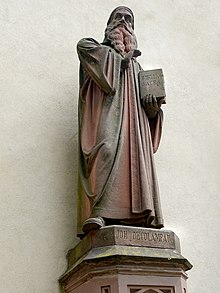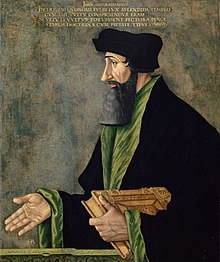Johannes Oekolampad
Johannes Oekolampad (also Ökolampad or Latinized Oekolampadius ; * 1482 in Weinsberg ; † November 24, 1531 in Basel , Switzerland ) was a theologian , humanist and the reformer of Basel.
Life

Johannes Oekolampad was born in the then Electoral Palatinate (since 1504 Württemberg ) town of Weinsberg. Birth name was (also written Husschyn, Hussgen, Huszgen or house bill) John Heussgen he, as usual at this time among humanists into Greek translated ( οἶκος oîkos , house 'and λαμπάς LAMPAS , lamp'). His father was a respected citizen , his mother came from a Basel councilor family .
From 1499 studied Oekolampad in Bologna rights in Heidelberg , Tübingen and Stuttgart theology , Hebrew and classical languages . From 1506 to 1508 he was the Palatine prince educator in Mainz. In 1510 Oekolampad was ordained a priest and got a pastor's position at the Johanneskirche in Weinsberg. There he caused offense with his reform-oriented sermons and therefore left the city in 1518.

During his studies in Tübingen, Stuttgart and Heidelberg he became acquainted with the humanists Johannes Reuchlin , Philipp Melanchthon and Wolfgang Capito . In 1515 Oekolampad went to Basel, where he worked for Erasmus von Rotterdam on the edition of the Novum Instrumentum omne , earned his doctorate in theology at the university and published Greek grammar and translations of patristic writings.
In 1518 he was appointed by Capito to the Basel Minster , soon afterwards to the cathedral in Augsburg , where shortly before the disputation "degenerate" interrogation between Martin Luther and Thomas Cajetan had taken place. Until then, committed to the tradition of Erasmus, he studied Luther's writings, therefore clashed with Johannes Eck and withdrew to the Altomünster monastery in 1520 . There he translated other Fathers of the Church and came to the point that he followed the doctrine of justification by faith alone and published his position in two scriptures. He then had to leave the monastery and became chaplain at the Ebernburg with Franz von Sickingen .
In 1522 he finally settled in Basel, where he translated other patristic writings. Jakob Meyer zum Hirzen (1473–1541), who was mayor of Basel from 1530 and the great-grandfather of Wolfgang Meyer , made friends with Oekolampad and became his loyal companion.
From 1523 he gave public lectures on the biblical prophets, was soon afterwards appointed professor against the will of the prince-bishop and finally in 1525 he was a priest in St. Martin's Church.
Hard arguments followed, also with Erasmus, and contacts with Huldrych Zwingli , Martin Bucer and Martin Luther. On the question of the Lord's Supper , Oekolampad followed Zwingli's point of view. In 1526 he was the leader of the Reformed at the Baden disputation and conducted the conversation against Johannes Eck. But the old belief still prevailed here.
Oekolampad enjoyed a high reputation, but never had such an influential position as Zwingli in Zurich, especially since Basel was a bishopric. Pressure from the population led to the secularization of some monasteries in 1525 , to freedom of belief for the Reformed in 1528 and to the abolition of Catholic worship in 1529.

In 1528 Oekolampad and Zwingli contested the Bern disputation . From 1529 he was an antistes of the Reformed Church in Basel, but also retained his Bible professorship. At Zwingli's side, he took part in the Marburg Religious Discussion , but accepted Martin Bucer's pamphlet of concord, which Zwingli had rejected. At five synods (1529 to 1531) he strove for church doctrine ( catechism ) and church discipline , which he wanted to hand over to a presbytery independent of the council . But there were ban authorities who carried out sermons and compulsory communion and carried out a cruel judgment on the Anabaptists .
In 1528 Johannes Oekolampad and Wibrandis Rosenblatt married . The marriage had three children. After a five-month widow's period, he married the widower Wolfgang Capito (1478–1541), who was 26 years his senior. After his death, Wibrandis Rosenblatt and Martin Bucer married in 1542.
In 1531 - a few weeks after Zwingli's death - Oekolampad died. His grave is in the Basel Minster. His successor as professor and pastor was the reformer Oswald Myconius .
Honors
One of the Basel parishes is named after him ( Oekolampad parish ). The Evangelical Church in Germany commemorates him with a memorial day on November 24th in the Evangelical Name Calendar .
Works
- Theophylacti Archiepiscopi Bulgariæ, in quatuor Euangelia enarrationes, Ioanne Oecolampadio interprete. Andreas Cratander , Basel 1524 ( digitized edition of the University and State Library Düsseldorf ).
- Johannes Oecolampadius: Popular lectures on the first letter of Johannis, translated from the Latin by Raget Christoffer. 1850 (reprint 2017).
literature
- Julius August Wagenmann: Oekolampad, Johannes . In: Allgemeine Deutsche Biographie (ADB). Volume 24, Duncker & Humblot, Leipzig 1887, pp. 226-236.
- Letters and files on the life of Oekolampads. For the four hundredth anniversary of the Basel Reformation . Edited by Ernst Staehelin. 2 volumes. Heinsius, Leipzig 1927 and 1934 (reprint: Johnson, New York and London 1971).
- Ernst Staehelin : The theological life work of Johannes Oekolampads . Heinsius, Leipzig 1939 (reprint: Johnson, New York and London 1971).
- Ernst Staehelin: The professional positions of Oekolampad during his four stays in Basel. In: Basler Zeitschrift für Geschichte und Altertumskunde , Volume 16, 1917, pp. 267–292 . ( Digitized version )
- Ernst Staehelin: Ecolampad Bibliography. List of ecological prints published in the 16th century. In: Basler Zeitschrift für Geschichte und Altertumskunde. Volume 17, 1918, pp. 1-119. ( Digitized version )
- Walter Troxler: OEKOLAMPAD, Johannes. In: Biographisch-Bibliographisches Kirchenlexikon (BBKL). Volume 6, Bautz, Herzberg 1993, ISBN 3-88309-044-1 , Sp. 1133-1150.
- Ulrich Gäbler : Johannes Oekolampad. In: Theological Real Encyclopedia. Volume 25. de Gruyter, Berlin / New York 1995, ISBN 3-11-014712-2 , pp. 29-39.
- Thomas Konrad Kuhn : Oekolampad. In: New German Biography (NDB). Volume 19, Duncker & Humblot, Berlin 1999, ISBN 3-428-00200-8 , p. 435 f. ( Digitized version ).
- Wilhelm Liebhart : Johannes Hausschein called Oecolampadius. In: Life pictures from ten centuries. A reading book for the exhibition in the Dachau District Museum, December 17, 1999 - March 19, 2000, with texts by Wilhelm Liebhart a. a. District Museum Dachau , Dachau 1999, ISBN 3-930941-20-1 .
- Olaf Kuhr: The power of ban and penance. Church discipline and renewal of the church with Johannes Oekolampad (1482-1531) . Peter Lang, Bern 1999, ISBN 3-906760-84-7 (dissertation University of Basel 1998, 315 pages).
- Olaf Kuhr: Oekolampad, Johannes. In: Historical Lexicon of Switzerland .
Individual evidence
- ↑ Paul Meyer: Jakob Meyer zum Hirzen (1473-1541). Retrieved May 17, 2020 .
- ↑ Johannes Oekolampad in the Ecumenical Lexicon of Saints
Web links
- Literature by and about Johannes Oekolampad in the catalog of the German National Library
- Works by and about Johannes Oekolampad in the German Digital Library
- Evidence of Latin works on the Internet
- Christine Christ von Wedel: Erasmus von Rotterdam and Johannes Oekolampad. In: Michael Welker, Michael Beintker, Albert de Lange: Europa reformata. Reformation cities of Europe and their reformers. Evangelische Verlagsanstalt, Leipzig 2016, ISBN 978-3-374-04119-0 , p. 45, excerpt retrieved January 25, 2018 ciando.com
| predecessor | Office | successor |
|---|---|---|
| no predecessor |
Antistes of the Basel Church 1529–1531 |
Oswald Myconius |
| personal data | |
|---|---|
| SURNAME | Oekolampad, Johannes |
| ALTERNATIVE NAMES | Oekolampadius, Johannes; Heussgen, Johannes |
| BRIEF DESCRIPTION | Swiss theologian and humanist; Reformer of Basel |
| DATE OF BIRTH | 1482 |
| PLACE OF BIRTH | Weinberg |
| DATE OF DEATH | November 24, 1531 |
| Place of death | Basel |
